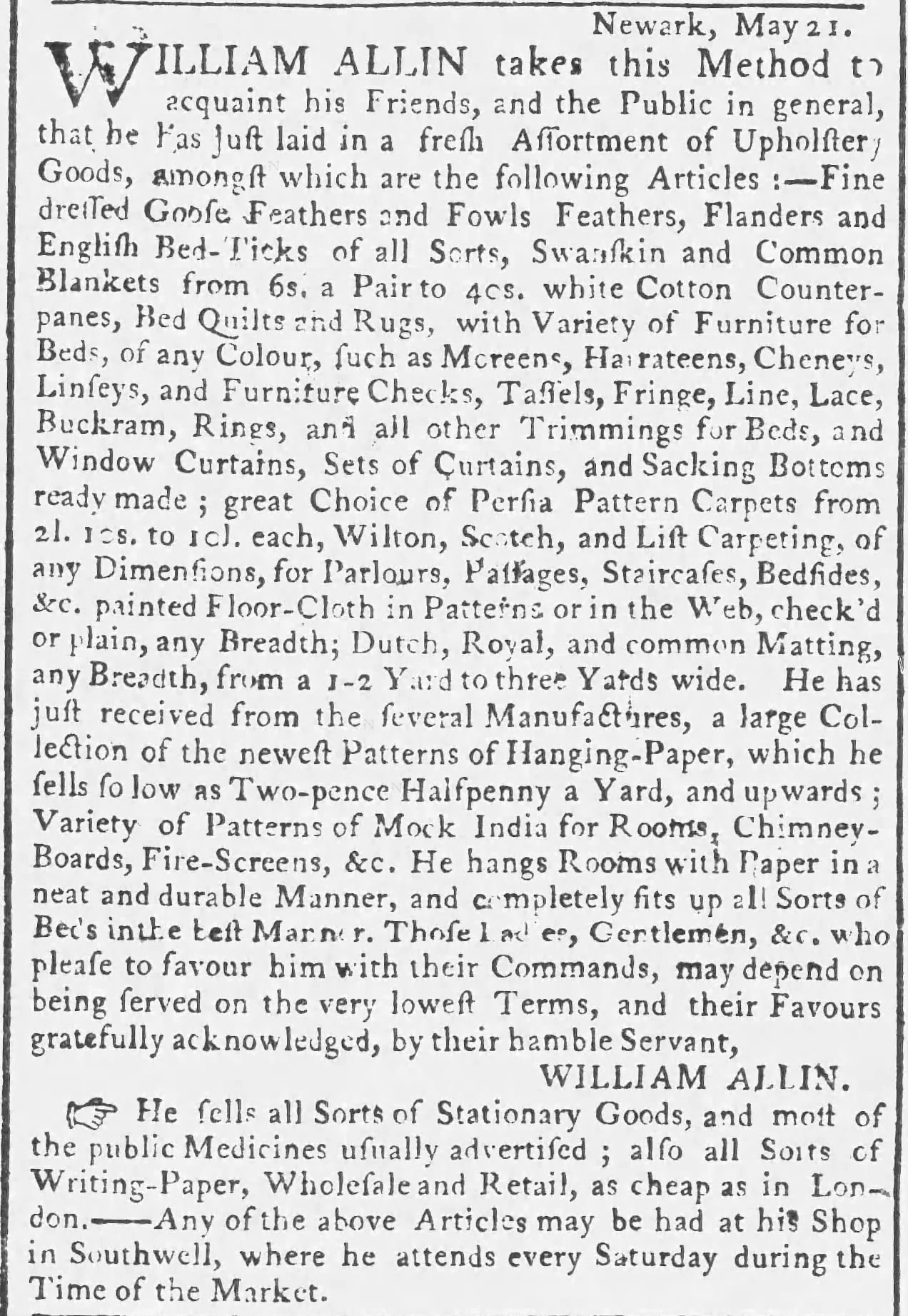Floorcloths
The London Tradesman (1747) comments on floorcloth-painting:
In the Turner’s Shop we generally meet with Floor-Cloths, painted in Oil Colours, which is performed by a Claſs of Painters who do little elſe. It requires no great Ingenuity, and the Wages of Journeymen is the same as in other Branches of Painting.
Instructions for cleaning floorcloths:
“Having well swept your floor-cloth, wipe it carefully with a flannel, and when all dust and spots are removed, rub it fist with a flannel slightly waxed, and then with a plain dry one. Or washing occasionally with milk, and dry rubbing may suffice without the use of the wax, and the floor-cloth will be less slippery.” (The Universal Cook and City and Country Housekeeper, 1806)
“The sides of stairs or passages on which are carpets or floor-cloth should be washed with sponge instead of linen or flannel, and the edges will not be soiled. Different sponges should be kept for the above two uses; and these and the brushes should be well washed when done with, and kept in dry places.” (The New London Family Cook, 1808; A New System of Domestic Cookery, 1808)
Floorcloth painters’ trade cards often feature images of floorcloths, perhaps illustrating some of the designs that were available. These include Joseph Barnes, The Hat & Floor Cloth Warehouse By James Cox, Gatfield & Co., B. Philpott, James Theebridge, Thomas Tillinghast, Joseph Weston, Alexander Wetherstone, and John White.
Additional Resources
This site contains affiliate links for which I may be compensated
Various kinds of floor decorations, 1739
Floor Coverings in 18th-Century America
Floor coverings in New England before 1850
The Floorcloth and Other Floor Coverings in the London Domestic Interior 1700-1800
Floor Cloths, Both Imported and Domestic in Floor Coverings in New England Before 1850
Painted Floorcloths: A Historical Perspective
Floor Coverings for Historic Buildings: A Guide to Selecting Reproductions
Floorcloth Magic: How to Paint Canvas Rugs for Decorative Home Use
Floorcloth details from 18th century trade cards
© The Trustees of the British Museum. Shared under a Creative Commons Attribution-NonCommercial-ShareAlike 4.0 International (CC BY-NC-SA 4.0) licence.
Carwitham’s Various Kinds of Floor Decorations (1739) provides “useful Designs for Ornamenting the Floors of Halls, Rooms, Summer Houſes, &c. whither in Pavements of Stone, or Marble, or with Painted Floor Cloths.”
Some of Carwitham’s designs resemble floor cloths illustrated on trade cards; this design also looks like the floor (or perhaps a floorcloth) in a c. 1770-1790 portrait of a child with a dog.
The Colonial Williamsburg Foundation. From the Abby Aldrich Rockefeller Collection, Gift of David Rockefeller
© The Trustees of the British Museum. Shared under a Creative Commons Attribution-NonCommercial-ShareAlike 4.0 International (CC BY-NC-SA 4.0) licence.
Possible floorcloths in 18th & 19th century images
Child with Dog, c. 1770-1790
Fragments of floorcloths at Winterthur, including 1961.1031
Floorcloths & fragments from Historic New England, including 1991.1372, 1966.2141, 2003.27.1, 1972.103
The Sargent family, 1800
Boy with Finch by John Brewster, Jr., c. 1800
Nathan Hawley and Family Nov. 3d, 1801 by William Wilkie
The Woolsey family by William Berczy, 1809
The artist’s family by George Scharf, 1830
Portraits attributed to Joseph H. Davis, 1830s: Mary Ann Cook, Lucy Vickery, John Stockbridge Vickery, the Hayes family, the Barrett sisters
Portraits attributed to Erastus Salisbury Field, including Boy on stenciled carpet (1838), Child holding rattle (1838), Joseph Moore and his family (1839), Margaret Gilmore (1845)
Floor cloth, and oil cloth covers in An Encyclopedia of Domestic Economy, 1852
Floor cloth manufacture in Ure’s Dictionary of Arts, Manufacture, and Mines, 1861
Four drawings showing the manufacture of floor cloth (Met 57.536.3)
18th century advertisements for floor cloths
Floorcloths are also advertised in lists of imported goods in the American colonies, such as Atkins & Weston of Charleston, Balfour & Barraud of Norfolk, Joseph Beddome of Philadelphia, Robert Coudoun of Annapolis, James Drummond of Charleston, Samuel Grove of Charleston, Mackenzie, Thomson, & Co. of Charleston. The household goods in the auction of the property of Mr. George King of Montreal included “painted Floor and Stair Cloths.”
The Gloucester Journal
March 31, 1741
The South-Carolina Gazette
November 12, 1750
Maryland Gazette
June 26, 1760
Maryland Gazette
August 30, 1764
The South-Carolina Gazette; and Country Journal
May 3, 1768
Cambridge Chronicle and Journal
May 26, 1770
The Public Register, or, Freeman's Journal
May 16, 1782
The Gloucester Journal
March 2, 1789
Bath Weekly Chronicle and Herald
December 19, 1793
The Times
May 2, 1794
The North American
November 13, 1795
Aurora General Advertiser
January 1, 1796




















